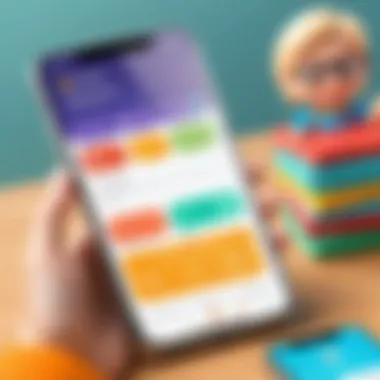Top Free Apps Every Daycare Provider Should Try


Intro
In recent years, daycare providers have faced increasing challenges in managing their operations efficiently. With the growing numbers of enrolled children and the expectations of parents, it becomes crucial to streamline various aspects such as communication, administration, and daily activities. Leveraging technology through free applications offers an effective solution to these problems. Selecting the right apps can transform how daycare providers manage their tasks, improve engagement with families, and create a better overall experience for all involved.
This article aims to explore essential free applications that serve daycare providers. We will detail the unique features of each app, outline the benefits, and discuss practical use cases that illustrate their value in a daycare setting. The focus will also include integrations that support the unique needs of providers, allowing caregivers to concentrate on nurturing children instead of drowning in administrative tasks.
Overview of Key Features
Essential Software Capabilities
Free apps for daycare providers offer a variety of functions that enhance daily operations. Key capabilities often include:
- Child profiles management: Keep detailed records of each child’s information, including contact details, emergency contacts, and medical records.
- Attendance tracking: Monitor attendance in real-time to comply with regulations and improve communication with parents.
- Daily reports: Provide parents with daily updates about their child's activities, meals, and mood, fostering transparency and trust.
- Payment tracking: Simplify payment processes to manage billing efficiently and minimize late payments or confusion about fees.
Unique Features That Differentiate Options
In addition to basic functions, many applications boast unique features that set them apart. Examples include:
- Photos and videos sharing: Some apps allow providers to share memorable moments throughout the day, reinforcing the connection between daycare and home.
- Customizable communication tools: Differentiate messaging options that suit diverse parenting styles and comfort levels.
- Parent engagement tools: Encourage parents’ active participation through surveys, event scheduling, or parent-teacher communication forms.
Integrating effective communication with parents not only enhances trust, but it builds a community around the daycare environment.
User Experience
Interface and Usability
The user interface of any application is crucial. A well-designed app should be intuitive, easy to navigate, and accessible even to those who are not tech-savvy. Many daycare applications prioritize ease of use to reduce the learning curve for providers and parents alike. Simple controls, clean layouts, and responsive design contribute to a smooth user experience.
Support and Community Resources
A strong support system can significantly enhance the overall experience. Many apps come with community forums or extensive help documentation. This allows users to connect with others in similar fields, share experiences, and ask for advice. Support channels also include customer service or FAQs that can quickly resolve technical issues without interrupting daily operations.
In summary, utilizing free applications in daycare settings can drive significant operational improvements. The right app can provide daycare providers with essential tools, enhance communication with families, and offer substantial administrative support. Not only does this save time, but it also allows caregivers to focus on what matters most—the children.
Overview of Daycare Management Challenges
Daycare management presents distinct challenges that require attention and strategic solutions. As providers aim for efficiency and quality care, they face obstacles that can hinder operations. Understanding these challenges is essential for enhancing the overall experience for both childcare providers and families.
Common Administrative Hurdles
Administrative tasks are often a significant burden for daycare providers. Managing enrollments, tracking attendance, and maintaining accurate records can be time-consuming. These activities consume valuable resources that could otherwise be directed toward enriching child development. Providers may find themselves struggling to organize paperwork, leading to potential miscommunications and errors.
The lack of an organized system can cause delays in billing and payments, impacting cash flow. Additionally, overseeing staff schedules and managing staff qualifications poses further complications. Embracing technology can effectively address these hurdles by automating processes and improving organization.
Communication Issues with Parents
Effective communication with parents is paramount in daycare settings. Misunderstandings can lead to strained relationships and a lack of trust. Parents must receive timely updates about their child's progress, health, and any incidents that occur during the day. However, traditional methods of communication, such as paper notes or verbal updates, can fall short.
By adopting digital communication tools, daycare providers can streamline interactions with parents. These tools offer instant messaging features, enabling quicker exchanges of information. Additionally, some apps allow for the sharing of pictures or daily reports, making it easier for parents to stay informed about their child's activities. Ultimately, improved communication contributes to a positive family experience and enhances parent satisfaction.
Maintaining Compliance with Regulations
Compliance with regulations is a critical aspect of running a daycare. Providers must adhere to local, state, and federal laws, which can be complex and ever-changing. Failures in compliance can result in fines, licensing issues, or even termination of operations. Daycare providers need to stay updated on regulations regarding health, safety, staffing, and curriculum.
To navigate this landscape, providers can benefit from using specific applications designed to assist with compliance tracking. These tools can help ensure that all necessary documentation is maintained and that staff certifications are up to date. Moreover, regular audits and reminders provided by technology can ease the burden of compliance management, promoting a safer and more reliable environment for children.
Importance of Technology in Daycare Management
In today’s fast-paced world, the integration of technology into daycare management is not merely advantageous; it is essential. Daycare providers face significant challenges, ranging from administrative burdens to compliance with regulations. By leveraging technology, these professionals can streamline their operations, improve communication, and ultimately enhance the quality of care they provide to children and families.
Benefits of Using Technology
The benefits of technology in daycare management are numerous and multifaceted. One of the most significant advantages is the time saved on administrative tasks. Many apps now automate processes such as attendance tracking, billing, and scheduling. This allows providers to focus more on the children and less on paperwork.


Additionally, apps enhance communication with parents. With features that allow for messaging, sharing photos, and real-time updates, parents can feel more connected to their child's daily activities. This transparency builds trust and strengthens relationships between daycare providers and families.
Another benefit is the data analytics capabilities that many apps provide. By tracking attendance patterns, meal preferences, and developmental milestones, providers can make informed decisions that improve the daycare environment. These insights help in tailoring services to meet the specific needs of children and families.
Data Management and Record Keeping
Managing data is a core component of daycare administration. Traditional methods of record keeping, often involving paperwork, are not only time-consuming but also prone to errors. Digital solutions offer a robust alternative, allowing for easier access and organization of critical information.
For example, child enrollment forms, emergency contacts, and health records can now be stored securely in one place. Accessing this information becomes instantaneous, which is vital during emergencies. Moreover, digital record keeping contributes to better compliance with regulations, reducing the risk of fines or legal issues that may arise from poor documentation.
Streamlining Daily Operations
Technology plays a crucial role in streamlining daily operations within daycare settings. Scheduling apps can help plan daily activities, manage staff shifts, and allocate resources more effectively. This organization leads to smoother operations and enhanced staff productivity.
Furthermore, classroom management tools assist educators in tracking individual children's progress, which can inform instructional methods and exercises tailored for each child’s developmental stage. In essence, these applications create an organized and efficient environment conducive to learning and growth, while also providing a solid foundation in administrative management.
"Embracing technology in daycare operations management is not an option; it is a necessity for those who wish to provide high-quality care and remain competitive."
By understanding and utilizing the critical role technology plays in daycare management, providers can create environments that promote not only efficiency but also foster the development of children. This strategic integration leads to better outcomes for children, families, and providers alike.
Key Features to Look for in Daycare Apps
Identifying the right applications for daycare management is crucial. It ensures that the needs of both providers and parents are met effectively. Understanding the key features of daycare apps plays a significant role in making an informed decision. Some specific elements greatly enhance workflow and communication. Here are essential features that providers should keep in mind when selecting daycare apps.
User-Friendly Interface
A user-friendly interface is paramount. Daycare providers often have limited time. They need to access information quickly without wasting precious hours. An intuitive design allows for seamless navigation. This means less training and more focus on the children. Apps should offer clear menus and easy-to-understand icons. Color coding can also help in quickly identifying sections. If the app is too complicated, it may lead to frustration among users. In contrast, a simple and efficient interface can increase efficiency exponentially.
Communication Tools
Effective communication is vital in any daycare setting. Apps should include features that facilitate interaction between providers and parents. Secure messaging systems are invaluable. They allow for real-time updates about a child's progress or any incidents. Alerts and notifications keep parents informed about important announcements. Furthermore, sharing photos and daily reports create a sense of connection. When parents feel engaged, they are more satisfied with the services provided. This strengthens the overall relationship between parents and daycare staff.
Reporting and Analytics
Reporting and analytics features help providers track performance. These functionalities enable the extraction of valuable insights. Daily attendance, developmental milestones, and incidents can be analyzed easily. Having this data at hand facilitates informed decision-making. For instance, understanding attendance patterns can help in resource allocation. Additionally, reports on child development can guide teaching strategies. This feature not only improves the quality of care but also enhances overall operational efficiency.
Parent Engagement Features
Parent engagement is essential for successful daycare operations. Apps should provide tools that encourage families to participate actively. These features might include event calendars, newsletters, or forums for parent discussions. Moreover, the option to input feedback can help improve services. Engaged parents tend to have better relationships with the daycare. They also help establish a supportive community. Offering features that foster such an environment is essential for any daycare app. It reflects a commitment to collaboration and transparency.
Engaging features create stronger ties between families and daycare providers, leading to a more supportive environment.
Recommended Free Apps for Daycare Providers
In the current landscape of daycare management, selecting the right applications is essential for optimizing operations and enhancing communication. Free apps can provide significant benefits when implemented effectively. They allow daycare providers to minimize administrative tasks while improving engagement with parents. This section focuses on important free apps along with their features and user feedback, aiming to help providers make informed decisions.
App One: Overview and Features
Core functionalities
The first app to note is KidKare. It streamlines billing and attendance tracking in one platform. Its core functionalities include meal tracking, automated billing, and user-friendly interfaces. The ability to integrate with various payment systems makes it a highly effective tool for daycare centers of any size. Moreover, the reporting features allow for quick assessments of attendance and revenue.
A unique feature of KidKare is its capacity to manage food programs effectively. This means providers can easily comply with nutrition guidelines, supporting healthier choices for children. Additionally, it promotes timely invoicing which is key for sustaining cash flow, a critical aspect of running a daycare.
User feedback
User feedback for KidKare is overwhelmingly positive. Many providers highlight its ease of use and supportive customer service. Some users appreciate the fact that it offers extensive templates for meal planning. However, a common critique revolves around occasional bugs during peak usage times. Nevertheless, the majority agree that its benefits outweigh these drawbacks.
App Two: Overview and Features
Core functionalities
Another noteworthy app is Brightwheel. This app enhances communication between educators and parents through daily reports and messaging features. It also allows for digital check-in and check-out processes, which add to overall security measures in daycare centers.
The communication capabilities are its most valued core functionalities. Brightwheel provides parents with updates on their child’s activities, meals, and naps in real-time. This transparency can foster stronger relationships, making it a popular choice among providers who prioritize parent engagement.


User feedback
Parents and providers alike commend Brightwheel for its user-friendly design. They often mention its mobile accessibility, which enables them to stay connected on the go. Some users wish for more customization options regarding notifications, but overall, it remains a highly regarded choice in daycare applications.
App Three: Overview and Features
Core functionalities
Next is Procare, a powerful solution for management and operations. Its core functionalities cover enrollment, billing, and communication all in one platform. Procare allows providers to quickly manage enrollments and family profiles, streamlining administrative work.
The unique financial management tools within Procare stand out. They help providers create and send invoices quickly. Automated reminders for overdue payments can help prevent income gaps, an essential for sustainable operations.
User feedback
Feedback on Procare has been largely supportive, with users appreciating the comprehensive nature of the platform. However, some find the initial setup a bit daunting. Despite this, many agree it is an invaluable resource once properly configured.
App Four: Overview and Features
Core functionalities
ClassDojo is another excellent free app for daycare providers, designed primarily for communication and engagement. ClassDojo helps build classroom culture by allowing for real-time feedback and easy sharing of updates with parents. Its functionalities also include a mobile app for classroom management, making it very convenient for busy educators.
What sets ClassDojo apart is its focus on positive reinforcement. Teachers can award points to children for good behaviors. This feature not only encourages positive behavior but also engages parents in their child's achievements.
User feedback
Users often describe ClassDojo as a game-changer for communication. They value the simplicity of communicating updates to parents daily. However, sometimes the point system can be perceived as too gamified, causing friction in how rewards are given. Overall, it remains a well-regarded option for fostering engagement.
App Five: Overview and Features
Core functionalities
Lastly, ChildCare Sage stands out with its focus on compliance and documentation. It offers essential functionalities like automated daily reports, attendance logs, and billing statements. This app is built to keep daycare providers organized and ensure they adhere to local regulations, which is critical.
The core of ChildCare Sage is its ability to maintain comprehensive tracking of childcare records, which can save providers time during audits. With a good documentation trail, providers can have peace of mind concerning compliance.
User feedback
Users of ChildCare Sage have expressed appreciation for its straightforward design and how it simplifies vital compliance documentation. Some have suggested improvements in its mobile interface for efficiency, but many point out it’s a must-have for managing regulations effortlessly.
Integrating Apps into Daycare Operations
Integrating applications into daycare operations offers significant advantages. It allows providers to enhance their daily functions while reducing the burden of traditional management tasks. For daycare centers already facing administrative or communication challenges, an appropriate app can contribute to smoother processes and improved interactions with parents.
Assessment of Current Processes
Before selecting an app, it is essential to evaluate the current operations. Assessing existing workflows helps to identify pain points and specific needs. Consider how data is managed, whether communication with parents meets expectations, and how regulations are being handled. An evaluation can include:
- Identifying inefficiencies: Understand where time is lost or duplicated efforts are occurring.
- Collecting feedback: Speak with staff members about their experiences and suggestions.
- Analyzing compliance status: Ensure that current practices align with regulatory requirements.
This comprehensive assessment will give better insight into which applications can effectively address the identified challenges.
Setting Up the Application
Once an appropriate app has been selected, the setup process is crucial. A well-planned installation ensures that the app functions as intended and contributes positively to daycare operations. Key steps in this phase include:
- Installing the App: Follow the provided guidelines for downloading and installing the app on the required devices.
- Customizing Features: Tailor the app settings to match the specific needs of the daycare. This may involve configuring communication channels and privacy settings.
- Integrating with Existing Systems: If needed, connect the app with existing software or tools to streamline information flow.
Taking the time to set up the application properly can lead to more efficient daily use.
Training Staff on New Tools
Introducing new tools to staff requires careful planning and execution. A successful training program increases comfort and proficiency with the app, thereby maximizing its benefits. Important considerations for this training phase include:


- Organizing Training Sessions: Schedule guided sessions where staff can explore app features hands-on.
- Providing Resources: Offer access to support materials, such as user manuals or video tutorials.
- Encouraging Ongoing Learning: Allow staff to ask questions and provide feedback post-training to improve understanding and utilization.
Training is a critical step towards ensuring that the integration of apps is successful, as it enables users to harness the full potential of the tools available to them.
Integrating applications into daycare operations can lead to improved efficiency, better communication, and enhanced compliance. Each of these steps contributes towards a seamless transition, allowing daycare providers to focus more on the care of children rather than managing operations.
Ensuring Data Security and Privacy
In the context of daycare operations, ensuring data security and privacy is crucial. Daycare providers handle sensitive information about children and families. This includes personal identification details, health records, and emergency contact data. Protecting this information not only complies with regulations but also builds trust with parents and guardians. As reliance on technology increases, so does the necessity for secure systems that safeguard this data from breaches or unauthorized access.
Understanding Privacy Regulations
Privacy regulations differ by region and may include laws like HIPAA in the United States or the GDPR in the European Union. Familiarizing oneself with these rules is essential for daycare providers. It helps in crafting policies that adhere to legal requirements.
Providers should consider the following:
- Data Collection: Understand what information is collected, why, and how it will be used.
- User Consent: Ensure parents grant permission for data collection and processing.
- Data Retention Policies: Establish how long personal information will be stored and the processes for deleting it securely.
Staying updated on these regulations will mitigate the risk of non-compliance and potential fines.
Choosing Secure Applications
Once daycare providers comprehend privacy regulations, selecting the right applications is next. Not all apps guarantee data security. To choose secure applications, consider the following key points:
- Encryption Standards: Ensure that the app uses strong encryption to protect data during transmission and storage.
- Access Controls: Look for apps that allow you to set user permissions, limiting access to sensitive information to authorized personnel only.
- User Reviews and References: Research how the app has performed in terms of security. Feedback from other users can provide insights into any potential vulnerabilities.
- Regular Updates: Ensure that the application is regularly updated by the developers. This allows them to patch known issues and maintain security standards over time.
"The most valuable asset in daycare settings is trust. A single data breach can affect the trust between parents and providers, impacting enrollment and reputation."
Incorporating these criteria when selecting applications can greatly enhance the security posture of daycare providers, assuring parents of the safety and confidentiality of their children's data.
Future Trends in Daycare Technology
The landscape of daycare management is evolving rapidly due to technological advances. Understanding future trends in daycare technology is essential for providers who wish to stay competitive and meet the needs of families effectively. As the child care industry faces increasing demands for transparency, efficiency, and engagement, these trends serve as critical indicators of where the industry is headed.
New technologies can address several pain points faced by daycare providers, including communication deficits, scheduling complexities, and record-keeping challenges. Keeping pace with these trends allows providers to enhance operational effectiveness, ensure compliance, and foster positive interactions with families.
Emerging Technologies to Watch
Several emerging technologies show great potential for transforming daycare operations. Among these are:
- Artificial Intelligence (AI): AI can assist in personalizing communication with parents by providing timely updates on their child's activities or health. Algorithms can also analyze data to improve scheduling and resource allocation.
- Cloud-Based Platforms: Cloud technology enables secure access to records and communications from anywhere. It enhances collaboration among staff and allows parents to access information remotely.
- Mobile Applications: Dedicated mobile apps can simplify booking processes, facilitate communication barriers, and provide parents with real-time notifications regarding their children.
- Internet of Things (IoT): IoT devices, such as smart cameras or health monitoring systems, can provide data analytics on children’s engagement and well-being, giving insights into their activities and health.
These technologies hold the promise of improving efficiencies and enhancing the overall experience for daycare providers and families alike.
Potential Impact on Daycare Management
The impact of these technologies on daycare management can be profound. Key areas of influence include:
- Increased Efficiency: By automating routine tasks, providers can focus more on child engagement rather than administrative duties. Technology minimizes the time spent on paperwork, allowing more time for interactions.
- Enhanced Communication: Technologies break down barriers, fostering a transparent flow of information between daycare providers and parents, which improves trust and satisfaction levels.
- Better Compliance: As regulations surrounding daycare facilities become more stringent, technology can assist in maintaining compliance through automated record-keeping and reporting functionalities.
- Data-Driven Insights: Advanced analytics can help daycare providers understand trends and patterns, enabling them to make informed decisions based on actionable data.
"Adopting these future trends is not just an option; it’s a necessity for daycare providers aiming to thrive in a competitive environment."
The End
In the landscape of daycare management, the adoption of free applications has emerged as a pivotal component for enhancing operational excellence. As daycare providers navigate the complexities of their responsibilities, the integration of these technological solutions offers significant advantages. These apps not only simplify administrative tasks but also foster stronger communication with parents and ensure compliance with essential regulations.
The importance of this conclusion lies in its encapsulation of the main insights from the article. Free apps streamline processes, reduce time spent on manual tasks, and allow providers to focus more on child care rather than administrative burdens. Through effective use of technology, providers can create a more engaging and responsive environment for families.
Summary of Key Points
- Streamlining Operations: Technology helps in managing day-to-day functions efficiently, leading to cost savings and improved service delivery.
- Communication Enhancement: Apps facilitate seamless interaction between daycare staff and parents, promoting transparency and trust.
- Regulatory Compliance: Staying abreast of regulations is simplified through apps that assist in record-keeping and reporting.
- Parental Engagement: Features in apps often enhance how parents interact with the daycare, fostering a collaborative approach to care.
Final Thoughts on Implementing Apps
As daycare providers consider incorporating free applications into their operations, it is vital to approach implementation strategically. Begin by assessing current administrative processes to identify areas where technology can deliver the greatest benefit. After selecting suitable applications, training staff effectively on how to utilize these tools is crucial for ensuring successful adoption.
Implementing these applications is not merely about acquiring software; it’s about transforming how daycare functions. The long-term benefits include reduced workload, improved parent relationships, and a more organized approach to compliance and data management. Thus, taking the step toward embracing these resources can lead to a more effective and rewarding daycare environment.
"The right tools can make all the difference in managing a daycare efficiently and effectively."
By recognizing the significance of technology and committing to its thoughtful use, daycare providers can significantly enhance both their operational capabilities and the overall experience for families.







